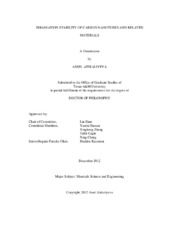| dc.contributor.advisor | Shao, Lin | |
| dc.creator | Aitkaliyeva, Assel 1985- | |
| dc.date.accessioned | 2013-03-14T16:13:38Z | |
| dc.date.available | 2014-12-12T07:18:55Z | |
| dc.date.created | 2012-12 | |
| dc.date.issued | 2012-09-28 | |
| dc.date.submitted | December 2012 | |
| dc.identifier.uri | https://hdl.handle.net/1969.1/148116 | |
| dc.description.abstract | Application of carbon nanotubes (CNTs) in various fields demands a thorough investigation of their stability under irradiation. Open structure, ability to reorganize and heal defects, and large surface-to-volume ratio of carbon nanotubes affect materials' radiation response so that it differs from their bulk counterparts. Despite the work conducted to this date, radiation damage and mechanisms governing the evolution of CNTs under irradiation are still deficient in fundamental understanding.
This dissertation is aimed to comprehend and characterize radiation response and crystalline-to-amorphous transition in ion and electron irradiated carbon nanotubes using various techniques, including but not limited to, transmission electron microscopy (TEM) and Raman spectroscopy. It shows that ion irradiation can be used to engineer properties of nanotubes in a controllable manner and significantly improve thermal diffusivity and conductivity of the material. This work also establishes the role of nuclear and electronic stopping powers in thermal diffusivity enhancement: thermal properties of irradiated CNTs are governed by nuclear stopping power of bombarding species. The change of thermal properties with irradiation is driven by two competing mechanisms: inter-tube displacement-mediated phonon transport and defect-induced phonon scattering. In addition to experiments, molecular dynamic simulations are used to confirm validity of the obtained results.
Radiation damage in CNTs at various temperatures as a function of ion energy, flux and fluence is examined. Mechanisms governing crystalline-to-amorphous transition under electron and ion irradiations are explored, applicability of previously suggested models discussed, and new models introduced. The results show enhanced defect annealing at elevated irradiation temperatures, which delays the formation of amorphous regions. Investigation of nanotube stability after various processing techniques and irradiation indicated that radiation response of CNTs in a composite is similar to that of individual nanotubes. | en |
| dc.format.mimetype | application/pdf | |
| dc.subject | transmission electron microscopy | en |
| dc.subject | Raman spectroscopy | en |
| dc.subject | thermal properties | en |
| dc.subject | irradiation | en |
| dc.subject | carbon nanotubes | en |
| dc.title | Irradiation Stability of Carbon Nanotubes and Related Materials | en |
| dc.type | Thesis | en |
| thesis.degree.department | Nuclear Engineering | en |
| thesis.degree.discipline | Materials Science and Engineering | en |
| thesis.degree.grantor | Texas A&M University | en |
| thesis.degree.name | Doctor of Philosophy | en |
| thesis.degree.level | Doctoral | en |
| dc.contributor.committeeMember | Hassan, Yassin | |
| dc.contributor.committeeMember | Cagin, Tahir | |
| dc.contributor.committeeMember | Cheng, Xing | |
| dc.contributor.committeeMember | Zhang, Xinghang | |
| dc.type.material | text | en |
| dc.date.updated | 2013-03-14T16:13:38Z | |
| local.embargo.terms | 2014-12-01 | |


